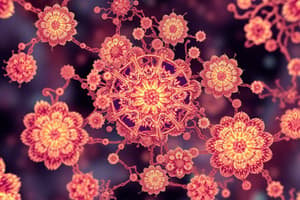Podcast
Questions and Answers
Match the following biological concepts with their corresponding descriptions:
Match the following biological concepts with their corresponding descriptions:
Scientific Method = A systematic approach involving observation, hypothesis testing, and analysis. Microscopy = A technique that enables the visualization of tiny structures, such as cells. Cells = The fundamental building blocks of all living organisms. Biological Diversity = The wide variety of life forms found on Earth, including plants, animals, fungi, and bacteria.
Match the following types of microscopy with their primary characteristics:
Match the following types of microscopy with their primary characteristics:
Light Microscopy = Uses visible light to illuminate and magnify specimens. Electron Microscopy = Employs a beam of electrons to create high-resolution images of extremely small structures. Scanning Electron Microscopy = Provides three-dimensional images of the surface of specimens. Transmission Electron Microscopy = Reveals the internal structures of cells and other biological materials.
Match the following types of cells with their defining features:
Match the following types of cells with their defining features:
Prokaryotic Cells = Lack a membrane-bound nucleus and other membrane-bound organelles. Eukaryotic Cells = Possess a membrane-bound nucleus and other membrane-bound organelles. Plant Cells = Have cell walls, chloroplasts, and large vacuoles. Animal Cells = Lack cell walls and chloroplasts, but have centrioles and lysosomes.
Match the following kingdoms of life with their characteristic features:
Match the following kingdoms of life with their characteristic features:
Match the following biological processes with their descriptions:
Match the following biological processes with their descriptions:
Flashcards
Scientific Method
Scientific Method
A step-by-step approach used by scientists to understand and explain natural phenomena. It includes observing, asking questions, forming hypotheses, conducting experiments, analyzing data, and drawing conclusions. This systematic method emphasizes testing hypotheses with empirical evidence.
Microscopy in Biology
Microscopy in Biology
Microscopes are powerful tools that allow us to magnify and visualize tiny structures that are invisible to the naked eye, like cells or bacteria. There are different types of microscopes, like light microscopes and electron microscopes, each with varying capabilities for magnification and resolution.
Cells - Basic Unit of Life
Cells - Basic Unit of Life
The fundamental building blocks of all living organisms. They are self-contained units that carry out all life processes necessary for survival, such as metabolism, growth, and reproduction.
Biological Diversity
Biological Diversity
Signup and view all the flashcards
Biological Processes
Biological Processes
Signup and view all the flashcards
Study Notes
Overview of the Video
- The video discusses key concepts of Biology, including the scientific method, microscopy, cells, and different biological types.
The Scientific Method
- The scientific method is a systematic approach for understanding the natural world.
- It involves observation, question formation, hypothesis development, experimentation, data analysis, and conclusion.
- The method emphasizes empirical evidence and testable hypotheses.
Microscopy
- Microscopy is crucial in biology, allowing visualization of cells and other tiny structures.
- Different types of microscopes, like light and electron microscopes, are discussed, highlighting their respective capabilities.
- Significant differences in resolution exist between microscopy types.
Cells
- Cells are the fundamental units of life.
- All living organisms are composed of cells, performing functions essential for survival.
- Various cell types exist, including prokaryotic and eukaryotic cells.
- Organelles and their functions within cells are explored.
Biological Diversity
- Biological classifications, including kingdoms (plants, animals, fungi, bacteria), are presented.
- These kingdoms are vital components of the biosphere, with significant roles.
- The vast diversity of organisms on Earth is highlighted.
Biological Processes
- Fundamental biological processes distinguishing life forms are covered.
- Cellular respiration and photosynthesis are examples of these processes.
- The essential functions of biological processes for organism survival are noted.
Importance of Biology
- Biology is crucial for understanding life processes, from basic cells to complex organisms.
- Relationships within ecosystems are examined.
Studying That Suits You
Use AI to generate personalized quizzes and flashcards to suit your learning preferences.
Description
This quiz covers essential topics in Biology, focusing on the scientific method, the role of microscopy, and the importance of cells as the basic units of life. Test your understanding of these foundational concepts and their applications in biological studies.




